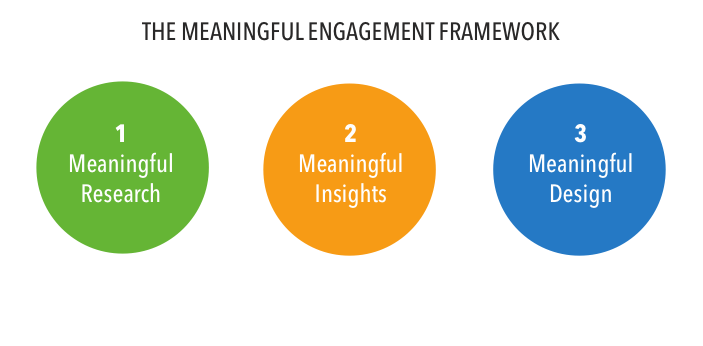At Red Privet, we utilize a three-step Meaningful Engagement Framework to identify Moments That MatterSM and create meaningful engagement.

Step 1: Meaningful Research
Meaningful research isn’t about validating your own assumptions, it’s about unearthing insights. Research should be designed to provide insight into three core components of the customer’s experience:
Intent
What are they trying to achieve?
What are their goals?
Their expectations?
Their assumptions?
How do they want to feel?
Context
What is their environment?
What tools and resources do they have?
Who influences their decision-making process?
Behavior
What do they actually do, think and feel throughout the process?
Contextual inquiry techniques such as contextual interviews, intercepts, and ethnography provide unprecedented access into the mind and world of your customer. These observation-oriented methods allow you to see your brand used in the context of the customer’s daily life and social networks. The goal in this step is to observe without judgment and seek to understand and empathize with your customers.
Step 2: Meaningful Insights
The next step in the process is uncovering Meaningful Insights. If you conducted your research well, you will be overwhelmed by information documenting the user experience. But information does not equal insight. In order to make meaning of what you have learned, we place that information in models and frameworks designed to highlight opportunity intersections.
Journey maps are a popular tool for planning customer engagement tactics. These artifacts provide a visual representation of all of the touchpoints a customer encounters as they use a brand’s product or service. The best journey maps are rich with real-life insights unearthed during Meaningful Research–through active listening and judgment-free observation of the customer. The key to unlocking insights is to identify not only the transactional interactions, but the emotional and social interplay as well.
Once all of the touchpoints have been identified and the entire customer experience has been plotted on a Journey Map, the next step is to look at the map through your engagement binoculars–one lens viewing it from the customer’s perspective, while the other considers the brand’s needs. The moments that matter are the interactions where you have the highest likelihood of achieving both the customers’ needs and business needs at the same time. This is where you invest your engagement energy to design the most meaning possible into each interaction.
Step 3: Meaningful Design
Meaningful Design isn’t just about creating a slick app or beautiful user interface. Meaningful Design goes beyond aesthetics to design complete, integrated experiences that meet needs, fulfill desires or exemplify shared values. In this step, Meaningful Insights become the design criteria and Meaningful Research informs the design process so every interaction is designed with the customer’s intent, context and behavior in mind.
Meaningful Design is also measurable design. Regardless of what form the experience takes–from a smartphone app to a customer call center script–a brand should be able to measure the impact of the interaction on both the top and bottom line.
So What Does This Mean For You?
It’s simple. Meaningful engagement leads to meaningful business results.
When you concentrate on meaningful engagement at the Moments That Matter, the whole becomes greater than the sum of its parts. The customer not only accomplishes the critical tasks they set out to achieve, they feel understood, supported and a deep sense of belonging. At the same time, your brand not only achieves its top line transactional and financial objectives, you also reap the benefits of bottom line efficiencies–while developing loyal brand advocates.
Creating even more Moments That Matter.
Excerpted from Meaningful Engagement: Connecting With Customers at the Moments That Matter, download the complete white paper here.
